Wind energy: The “least sustainable energy option”
Sep 2, 2011
“Our Least Sustainable Energy Option”
The images in this posting are from Windtoons, and were added by WTS.com
·
Paul Driessen, TownHall.com (9/1/11)
President Obama and a chorus of environmentalists, politicians, corporate executives and bureaucrats are perennially bullish on wind power as the bellwether of our “clean energy economy of the future.”
In reality, wind energy may well be the least sustainable and least eco-friendly of all electricity options. Its shortcomings are legion, but the biggest ones can be grouped into eight categories.
Land. As American humorist and philosopher Will Rogers observed, “They ain’t making any more of it.” Wind turbine installations impact vast amounts of land, far more than traditional power plants.
Arizona’s Palo Verde nuclear plant generates 3,750 megwatts of electricity from a 4,000-acre site. The 600-MW John Turk ultra-supercritical coal-fired power plant in Arkansas covers part of 2,900 acres; two 600-MW coal-fired units in India use just 600 acres. Gas-fired units like Calpine’s 560-MW Fox Energy Center in Wisconsin require several hundred acres. All generate reliable power 90-95% of the year.
By contrast, the 600-MW Fowler Ridge wind installation (355 turbines) spans 50,000 acres of farm country along Indiana’s I-65 corridor. The 782-MW Roscoe project in Texas (627 turbines) sprawls across 100,000 acres. Oregon’s Shepherds Flat project (338 gigantic 2.5 MW turbines) covers nearly 80,000 wildlife and scenic acres along the Columbia River Gorge, for a “rated capacity” of 845 MW.
The Chokecherry-Sierra Madre project will blanket some 320,000 acres of sage grouse habitat and BLM land in Wyoming with 1,000 monstrous 3-MW turbines, to generate zero to 3,000 MW of intermittent power. That’s eight times the size of Washington, DC, to get an average annual output one-fourth of what Palo Verde generates 90% of the time. But C-SM has already received preliminary approval from BLM.
To replace just 20% of the United States’ 995,000 MW of total installed generating capacity, we would need to blanket an area the size of Kansas with wind turbines, and then add nearly a thousand 600-MW gas-fired backup generators … and thousands of miles of new high voltage transmission lines.
Raw materials. Wind turbine installations require vast amounts of steel, copper, rare earth metals, fiberglass, concrete, rebar and other materials for the turbines, towers and bases.
A single 1.7 MW wind turbine, like 315 of the Fowler Ridge units, involves some 365 tons of materials for the turbine assembly and tower, plus nearly 1100 tons of concrete and rebar for the foundation. Bigger units require substantially more materials. Grand total for the entire Fowler wind installation: some 515,000 tons; for Roscoe, 752,000 tons; for Shepherds Flat, 575,000 tons; for Chokecherry, perhaps 2,000,000 tons. Offshore installations need far more raw materials.
To all that must be added millions of tons of steel, copper, concrete and rebar for thousands of miles of transmission lines – and still more for mostly gas-fired generators to back up every megawatt of wind power and generate electricity the 17 hours of each average day that the wind doesn’t blow.
Money. Taxpayers and consumers must provide perpetual subsidies to prop up wind projects, which cannot survive without steady infusions of cash via feed-in tariffs, tax breaks and direct payments.
Transmission lines cost $1.0 million to $2.5 million per mile. Landowners get $10,000 per turbine, plus royalties on all energy produced from the turbine, plus payments for every foot of access road and transmission lines. However, taxpayers pay more, while the landowners’ neighbors suffer property devaluation, scenic disruption, noise, health problems and interference with crop spraying, but no monetary compensation. Direct federal wind energy subsidies to help cover this totaled $5 billion in FY 2010; state support added billions more; still more billions were added to consumers’ electric bills.
The Other People’s Money well is running dry. The “manmade catastrophic climate change” thesis behind the wind energy campaign is in shambles. Voters and consumers are understandably fed up.
Energy. Mining, quarrying, drilling, milling, refining, smelting and manufacturing operations make the production of metals, concrete, fiberglass and resins, turbines, and heavy equipment to do all of the above very energy-intensive. Ditto for transporting and installing turbines, towers, backups and transmission lines. That takes real energy: abundant, reliable, affordable – not what comes from wind turbines.
In fact, it probably requires more energy to manufacture, haul and install these monstrous Cuisinarts of the air and their transmission systems than they will generate in their lifetimes. However, no cradle-to-grave analysis has ever been conducted, for the energy inputs or pollution outputs. We need one now.
Health. Whereas environmentalists garner scary headlines over wildly speculative claims about health dangers from hydraulic fracturing (to extract abundant natural gas for wind turbine backup generators), they ignore and dismiss a growing body of evidence that wind turbines cause significant health problems.
Principal health issues are associated with noise – not just annoying audible noise, but inaudible, low-frequency “infrasound” that causes headache, dizziness, “deep nervous fatigue” and symptoms akin to seasickness. “Wind turbine syndrome” also includes irritability, depression, and concentration and sleep problems. Others include “shadow flicker” or “strobe effect” from whirling blades, which can trigger seizures in epileptics, “vibroacoustic” effects on the heart and lungs, and non-lethal harm to animals. Serious lung, heart, cancer and other problems have been documented from rare earth mining, smelting and manufacturing in China, under its less rigorous health, workplace and environmental regulations.
To date, however, very few health assessments have been required or conducted prior to permit approval, even for major wind turbine installations. Perhaps the trial lawyers’ guild could redress that oversight.
Environment. Raptors, bats and other beautiful flying creatures continue to be sliced and diced by wind turbines. Thankfully, the Bureau of Land Management has included an “avian radar system” to track the slaughter within its 500-square-mile Chokecherry region – and banned mining among the turbines.
Wind turbines are supposed to reduce pollution and carbon dioxide emissions. But because backup generators must repeatedly surge to full power and back to standby, as wind speed rises and falls, they operate inefficiently, use more fuel and emit more – much like cars forced to stop repeatedly on freeways.
Jobs. The myth of “green jobs” is hitting the brick wall of reality. While the turbines are installed in the USA and EU, far more numerous mining and manufacturing jobs are in China, where they are hardly “green.” As Spanish and Scottish analysts have documented, the “green” installer and maintenance jobs cost up to $750,000 apiece – and kill 2.2 to 3.7 traditional jobs for every “eco-friendly” job created.
Electricity costs and reliability. Even huge subsidies cannot cure wind power’s biggest defects: its electricity costs far more than coal, gas or nuclear alternatives – and its intermittent nature wreaks havoc on power grids and consumers. The problem is worst on hot summer afternoons, when demand is highest and breezes are minimal. Unable to compete against cheap Chinese and Indian electricity and labor, energy-intensive industries increasingly face the prospect of sending operations and jobs overseas. Bayer Chemical’s warning that it may have to close its German facilities is just the tip of the iceberg
When it comes to wind, Nat King Cole might have sung: “Unsustainable that’s what you are, unsustainable though near or far. Unsustainable in every way, and forever more that’s how you’ll stay.” Well, maybe not forever, but certainly for the foreseeable future.
So take a hint from Spoon’s lively tune and “cut out the middleman.” Forge a direct relationship with energy you can afford, energy that works nearly 24/7/365, energy that causes the least ecological damage and is far more sustainable than wind power: the hydrocarbon, hydroelectric and nuclear power that have sustained our society and brought unprecedented health, prosperity and living standards to billions.
Then help the planet’s least fortunate people to do likewise.

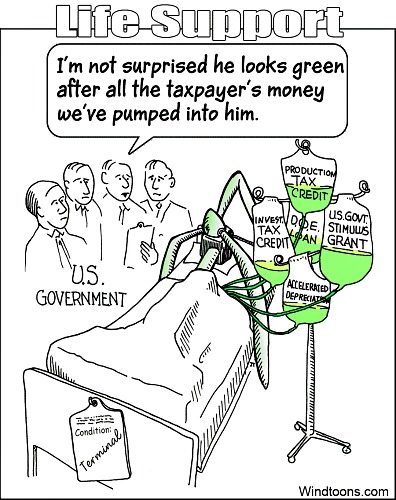
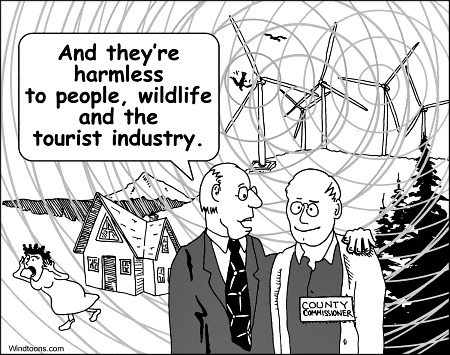
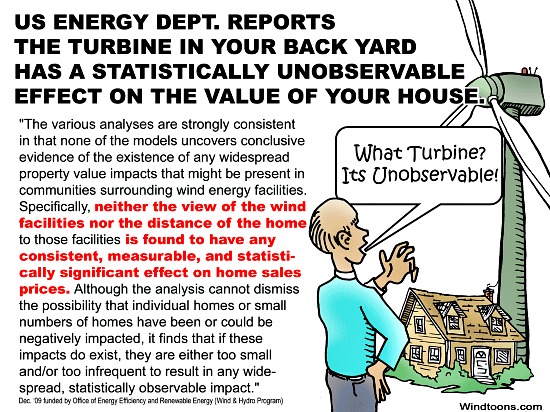
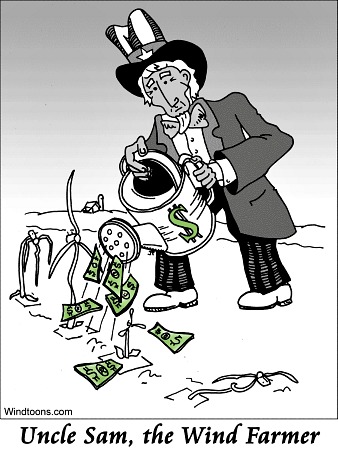
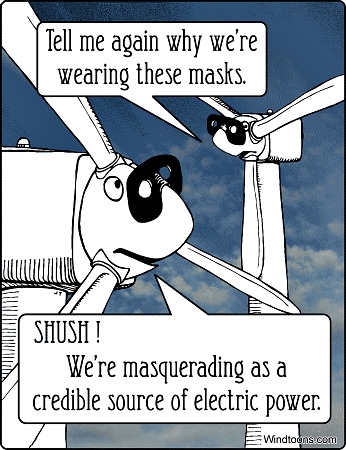
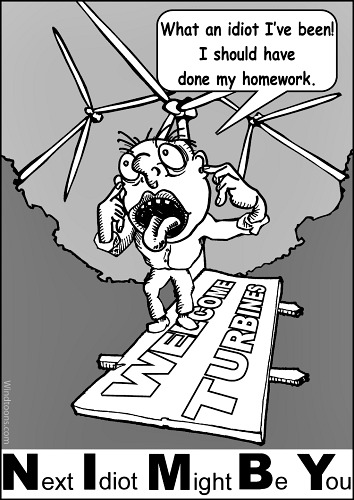
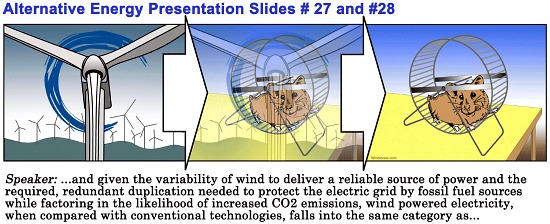
Comment by Sue Bowen on 09/03/2011 at 6:59 am
Here in the UK there is only one political party commited to decommissioning wind turbines at the cost, where possible, of the land owners who had them erected. As a policy we intend that no more subsidies will be given to this form of energy generation. We also intend to use British open-cast coal deposits for the newer and cleaner fossil fuel powerstations. Britain has at least 350 years’ supply of coal in just one area of the Northeast. Additionally we intend to invest in nuclear power.
No other UK political party has apparently even considered the problem, or they have brushed it under the carpet.

.
Comment by Itasca Small on 09/05/2011 at 11:35 pm
This has to be the most colossal con-game in history! Are we going to be conned here in North America as badly as the rest of the globe? When they are ahead of us in this debacle, and we should be able to learn from their unfortunate mistakes? You have to want to learn the truth, or you will have to make your own mistakes. There has to be a strategy that will get the attention of the indoctrinated masses. I just refuse to believe that they would still be on the side of wind energy if they really heard the facts. So what is the answer, beyond being sure to pray for hearts, minds, and souls to be opened to the truth?
Comment by Denise on 09/07/2011 at 1:14 pm
“You have to want to learn the truth, or you will have to make your own mistakes. There has to be a strategy that will get the attention of the indoctrinated masses. I just refuse to believe that they would still be on the side of wind energy if they really heard the facts. So what is the answer, beyond being sure to pray for hearts, minds, and souls to be opened to the truth?”
this is the bottom line…in your heart of hearts, what do you believe?
Comment by Mike on 03/25/2012 at 7:21 pm
The destruction of mountain watersheds in VT and ME in US are well documented. What some communities are finding are the health risks of living within a mile of these massive areas. The solution of the wind companies and politicians is to locate them in former wildlife habitats. The footprint, as the article states, is hundreds of thousands of acres.
Tax subsidies for residential solar would be taxes better used and cut out the energy corporations, who will double our electric bills, as was recently reported in Denmark. Better the devil you know than the one you don’t.
But we are federal revenue streams and we’ll never be supported as a people over corporate and political greed.